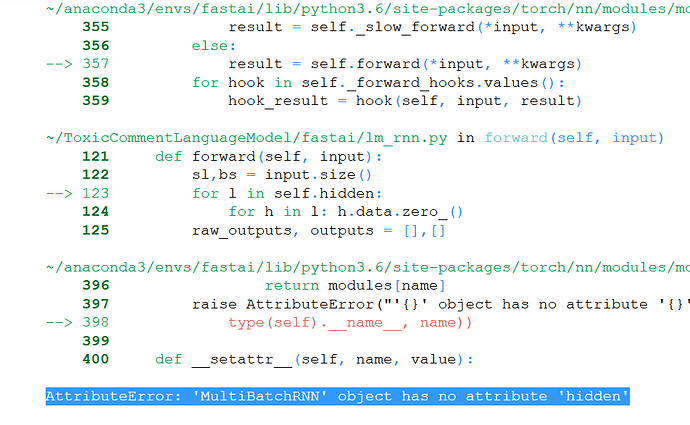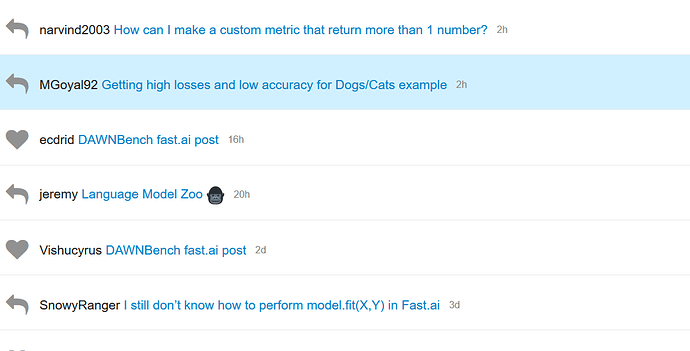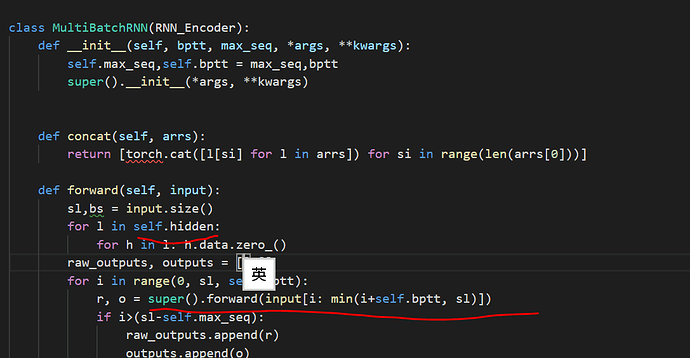It fixed that error. I was running out of memory on 4GB GPU, so I decreased bs=16, and now there is another error running learner.fit
RuntimeError Traceback (most recent call last)
<ipython-input-20-b544778ca021> in <module>()
----> 1 learner.fit(lrs/2, 1, wds=wd, use_clr=(32,2), cycle_len=1)
C:\Users\Developer\fastai\courses\dl2\fastai\learner.py in fit(self, lrs, n_cycle, wds, **kwargs)
285 self.sched = None
286 layer_opt = self.get_layer_opt(lrs, wds)
--> 287 return self.fit_gen(self.model, self.data, layer_opt, n_cycle, **kwargs)
288
289 def warm_up(self, lr, wds=None):
C:\Users\Developer\fastai\courses\dl2\fastai\learner.py in fit_gen(self, model, data, layer_opt, n_cycle, cycle_len, cycle_mult, cycle_save_name, best_save_name, use_clr, use_clr_beta, metrics, callbacks, use_wd_sched, norm_wds, wds_sched_mult, use_swa, swa_start, swa_eval_freq, **kwargs)
232 metrics=metrics, callbacks=callbacks, reg_fn=self.reg_fn, clip=self.clip, fp16=self.fp16,
233 swa_model=self.swa_model if use_swa else None, swa_start=swa_start,
--> 234 swa_eval_freq=swa_eval_freq, **kwargs)
235
236 def get_layer_groups(self): return self.models.get_layer_groups()
C:\Users\Developer\fastai\courses\dl2\fastai\model.py in fit(model, data, n_epochs, opt, crit, metrics, callbacks, stepper, swa_model, swa_start, swa_eval_freq, **kwargs)
130 batch_num += 1
131 for cb in callbacks: cb.on_batch_begin()
--> 132 loss = model_stepper.step(V(x),V(y), epoch)
133 avg_loss = avg_loss * avg_mom + loss * (1-avg_mom)
134 debias_loss = avg_loss / (1 - avg_mom**batch_num)
C:\Users\Developer\fastai\courses\dl2\fastai\model.py in step(self, xs, y, epoch)
55 if self.loss_scale != 1: assert(self.fp16); loss = loss*self.loss_scale
56 if self.reg_fn: loss = self.reg_fn(output, xtra, raw_loss)
---> 57 loss.backward()
58 if self.fp16: update_fp32_grads(self.fp32_params, self.m)
59 if self.loss_scale != 1:
C:\Users\Developer\Anaconda3\envs\fastai\lib\site-packages\torch\tensor.py in backward(self, gradient, retain_graph, create_graph)
91 products. Defaults to ``False``.
92 """
---> 93 torch.autograd.backward(self, gradient, retain_graph, create_graph)
94
95 def register_hook(self, hook):
C:\Users\Developer\Anaconda3\envs\fastai\lib\site-packages\torch\autograd\__init__.py in backward(tensors, grad_tensors, retain_graph, create_graph, grad_variables)
87 Variable._execution_engine.run_backward(
88 tensors, grad_tensors, retain_graph, create_graph,
---> 89 allow_unreachable=True) # allow_unreachable flag
90
91
RuntimeError: inconsistent range for TensorList output




